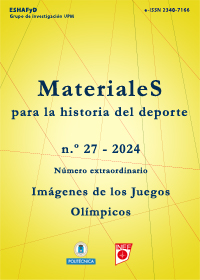Introduction to the special issue: Images of the Olympic Games
DOI:
https://doi.org/10.20868/mhd.2024.27.5245Resumo
The Olympic Games are an exceptional global event; held every 4 years and receive exponential media coverage. The two weeks of competition are unforgettable, generating countless images of sporting achievements, host cities and sporting events. They create stories –some marvellous, others
dramatic– around the athletes, but also events within the event. They create images and construct representations. The Olympic institution and the various stakeholders (sports organisations, sponsors, broadcasters, host territories, etc.) commit themselves to take over the production process of these representations and control them in order to ensure that their strategies/policies are implemented.
Image is primarily controlled by the International Olympic Committee. The international sports institution exists through its image; it must control and sustain it (Giesen & Hallmann 2018) to keep support from the public and therefore from the media as well as companies. Indeed, the Partners
programme implemented in the 1980s and supported by Juan Antonio Samaranch, President of the IOC from 1980 to 2001, is based on the benefits that companies hope to gain from this partnership, which is primarily a matter of image (Stipp 1998). As Marc Lits (1997) explains, it is because of the
way an event is portrayed by the media that it actually becomes an event. This makes it a godsend both for corporations, which can use it as a means of making money, and for athletes, as part of the commodification of sport and the Olympic Games that began in the 1980s. The question of image as iconography, but also as representation, is therefore central to the long-term future of an event like the Olympic Games.
Of course, private and commercial issues are linked to public ones. The commitment of host cities and their country is largely driven by the desire to (re)build an appealing image. The attractiveness of the area for tourism or commercial activities is fundamental (Kenyon & Bodet 2012; Hahm, Taci & Terry 2018).
The image issues raised by public actors are also symbolic and cultural. Opening ceremonies are the best examples to express the host country's history, culture and values (Hogan 2003; Kramavera & Grix 2023). Minorities who make demands, whether peacefully or violently, also disrupt the Games to take advantage of the spotlight they represent. But national identity remains at the heart of the Games, as flags are raised, and anthems sung at the end of each event. These symbols are in many ways an extension of an international competition between countries defending their athletic performance in a globalised society. In this respect, the medals won by champions help to forge
sporting identities and, by extension, national identities.
Through the various articles in this issue, we intend to contribute to this vast and complex theme. We do not claim to exhaust the subject, but rather to shed light on some of its aspects. Through their diversity, the authors offer complementary perspectives on various Olympics, sports, and countries.
Downloads
Referências
Giesen, N., & Hallmann, K. (2018). The impact of the perceived image and trust in the International Olympic Committee on perceptions of the Olympic Games in Germany. International journal of sport policy and politics, 10(3), 509-523.
Hahm, J., Tasci, A. D., & Terry, D. B. (2018). Investigating the interplay among the Olympic Games image, destination image, and country image for four previous hosts. Journal of Travel & Tourism Marketing, 35(6), 755-771.
Hogan, J. (2003). Staging the nation: Gendered and ethnicized discourses of national identity in Olympic opening ceremonies. Journal of Sport and Social Issues, 27(2), 100-123.
Kenyon, J. A., & Bodet, G. (2018). Exploring the domestic relationship between mega-events and destination image: The image impact of hosting the 2012 Olympic Games for the city of London. Sport Management Review, 21(3), 232-249.
Kramareva, N., & Grix, J. (2023). Understanding Russia’s identity through Olympic ceremonies. European Journal for Sport and Society, 20(1), 79-100.
Lits, M. (1997). Le récit médiatique : Un oxymore programmatique ? Recherches en communication, (7), 37‑59.
Stipp, H. (1998). The impact of Olympic sponsorship on corporate image. International Journal of advertising, 17(1), 75-87.
Downloads
Publicado
Edição
Secção
Licença
Os autores que têm publicações nesta revista aceitam os seguintes termos:
a. Os autores conservarão os seus direitos autorais e garantirão à revista o direito de primeira publicação da sua obra, que estará simultaneamente sujeita à Licença de Reconhecimento Creative Commons que permite a terceiros partilhar a obra desde que o seu autor e a sua primeira publicação nesta revista sejam indicados.
b. Os autores podem adoptar outros acordos de licença não exclusiva para a distribuição da versão publicada da obra (por exemplo: depositá-la num arquivo telemático institucional ou publicá-la num volume monográfico), desde que seja indicada a publicação inicial nesta revista.
c. Os autores são autorizados e encorajados a divulgar o seu trabalho através da Internet (por exemplo, em arquivos telemáticos institucionais ou no seu website) antes e durante o processo de submissão, o que pode levar a trocas interessantes e aumentar as citações do trabalho publicado. (Ver O Efeito de Acesso Aberto).












